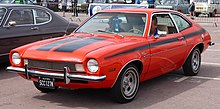Subcompact car is a North American classification for cars smaller than a compact car. It is broadly equivalent to the B-segment (Europe), supermini (Great Britain) or A0-class (China) classifications.
According to the U.S. Environmental Protection Agency (EPA) car size class definition, the subcompact category sits between the "minicompact" and "compact" categories.[1] The EPA definition of a subcompact is a passenger car with a combined interior and cargo volume of 85–99 cubic feet (2,410–2,800 L).[2] Current examples of subcompact cars are the Nissan Versa and Mitsubishi Mirage. The smaller cars in the A-segment/city car category (such as the Chevrolet Spark and Smart Fortwo) are sometimes called subcompacts in the U.S., because the EPA's name for this smaller category — "minicompact" — is not commonly used by the general public.[3]
The prevalence of small cars in the United States increased in the 1960s due to increased imports of cars from Europe and Japan. Widespread use of the term subcompact coincided with the early 1970s increase in subcompact cars built in the United States. Early 1970s subcompacts include the AMC Gremlin, Chevrolet Vega, and Ford Pinto.
- ^ "subcompact". merriam-webster.com. Retrieved 16 July 2017.
- ^ "FAQ - How are vehicle size classes defined?". www.fueleconomy.gov. Retrieved 5 January 2012.
- ^ Patton, Phil (9 September 2012). "Taking the 'Cheap' Out of the Small Car". The New York Times. Retrieved 10 September 2012.

